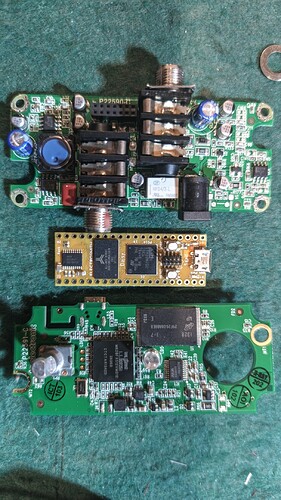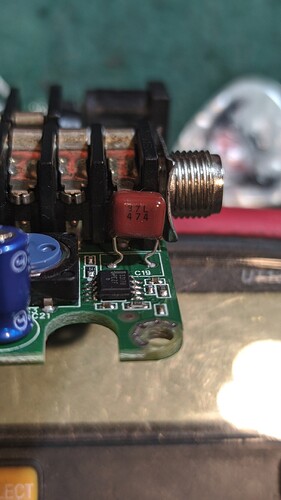Hi guys! Really awesome work!
How can you compare your hardware (mostly DAC I suppose) with one TC electronic and Strymon are using in their devices?
Asking because I’m a kinda sound purist and TC was the first digital stompbox I came across with impeccable sound quality.
What type of SMD capacitors for DAC are you using? Ceramic?
Eager to upgrade my device with your module.
Never thought I’d get to meet a capacitor connoisseur!
1 Like
prikin’ da, svintus, hahahahaha
Had to say the latest SMD 10 uF ceramic I tried were no brainer. But old habits die hard) I remember how bad were capacitors in Eelectro Harmonix stuff.
Do you realize that this is a platform for writing DSP code in first place? It’s not like that is what you do with TC/Strymon, etc.
Sorry, you got me confused.
Is it a different architecture? ADC-DSP-DAC?
It’s an audio codec (AK4556)+ STM32 microcontroller + SDRAM chip + QSPI flash on a single board. The important difference is not hardware platform, but open software. But if you have special requirements for codec used, you can look up its datasheet.
Like someone else said look at the data sheet. I’m not gonna say the Daisy is like $3,000 mastering converter, but it sounds alright to me.
My opinion aside, here is the chip they use,
If you’re after true hi fidelity in guitar pedals though, I would be running only analog pedals with a 9-18v linear dc power supply. Well that is actually what I do. The 5V psu for my eurorack also has a 9 and 18V DC send out.
I have a TC electronic rack reverb that I could compare to the daisy’s reverb. But that would tell us very little.
I release music commercially and, I’m not name dropping I’m just trying to let you know that we come from a similar place of audio fidelity (and in my case maybe it’s a sort of paranoia  )… I use a Dangerous AD+ and an Apogee Symphony for my studio I/O. So I’m not just like “eh it’s fine. Sounds just as good as my laptop speakers and scarlet interface.”
)… I use a Dangerous AD+ and an Apogee Symphony for my studio I/O. So I’m not just like “eh it’s fine. Sounds just as good as my laptop speakers and scarlet interface.”
I don’t think you’ll be disappointed by it.
3 Likes
Okay. I’ve got the answers.
Comparing to my TC Electronics, Seed have a faster processor, less memory (512 MB vs 2 GB) and exactly the same DAC.
I’ve compared a simple looper program Youtube link and found that I prefer the Seed’s sound quality:
// original looper code is pretty unusual for a guitarist needs so I changed to
buf[pos] = buf[pos] * drywet + in[i];
output = output * drywet + in[i];
//
Why not SMD? 0_0
3 Likes
Yep seems about right. Daisy can be scary fast with the right patch. There could be some error in here idk. But right now sending a pulse through at 48khz and loopback in another channel I get around 28 samples of latency. So about 0.5ms of latency. Which for a complex eurorack fx module is like among the best.
That’s with Daisy at 96khz and 8 block size. Running at 63%cpu, triple algorithmic saturator into a summing mixer. Not every program can run like that of course. My TC M350 rack reverb is at like 78 samples? I don’t quite remember but it’s over 2ms. That’s using one of the compressor settings to avoid any pre-delay in the reverb. So Daisy can be at least 4X faster. And the Max/Gen Dattoro reverb port sounds amazing.
And on top of that, Daisy can run 2 (or more I guess). And 2 ping pong delays. And volume automation programming, and a summing mixer… All at the same time lol at 96khz. Amazing. That max stuff just blows my mind and if I really end up doing a lot of live modular stuff, I will absolutely need a second Patch.
2 Likes
 )… I use a Dangerous AD+ and an Apogee Symphony for my studio I/O. So I’m not just like “eh it’s fine. Sounds just as good as my laptop speakers and scarlet interface.”
)… I use a Dangerous AD+ and an Apogee Symphony for my studio I/O. So I’m not just like “eh it’s fine. Sounds just as good as my laptop speakers and scarlet interface.”
